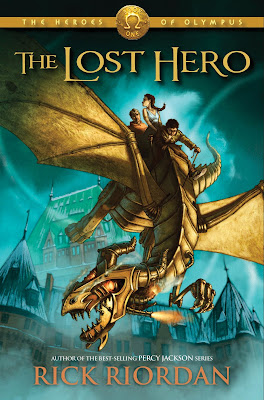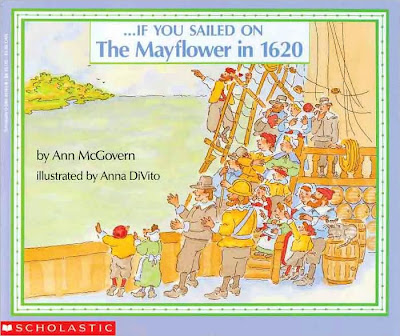
Monday, November 29, 2010
The TV Experiment

Friday, November 26, 2010
Sobering Statistics
 Before kindergarten:
Before kindergarten:- More than 30% of low-income children have no familiarity with print -- they don't know which way up to hold a book, or where the story starts and ends, or that we read from left to right. 17% of middle-income kids and 8% of those with college-educated parents also lack this knowledge.
- About 60% of low-income kids don't know the alphabet. More than 30% of middle-income kids don't know it either. That's one in three for middle-income kids.
- Only a mere 6% of low-income and 18% of middle-income kids understand numerical sequence. (Stats compliments of Kappan Magazine, Nov. 2010)

The good news is that we have the tools to fix all these problems right at home.
- Read to your child every day. 20 minutes is an absolute minimum. Aim for 30 or 40. Spread it out during the day, if possible. If your child is in daycare, ask how often the daycare provider reads to the kids. Talk about how we hold books, point out which side we start reading from, look for the beginning and the end of each book.
- Invest in or check out some alphabet books. Read them. Get or make some alphabet flash cards (use 3x5 index cards, write each letter on one card in clear, block form. Cut out magazine pictures of things that start with that letter, or draw a picture if you're artsy.) Sing the alphabet song -- here's a whole bunch of people singing the classic version, or watch this version on YouTube, or SuperWhy's version.
- I don't say this very often, but some TV shows do a nice job of reinforcing letter and number concepts. On PBS, Sesame Street, SuperWhy and Between the Lions would be my picks for the basics. Martha Speaks and Word Girl are good vocabulary builders. On Nick Jr., Dora the Explorer does a lot with counting, so that might be a good choice. The classic Blues Clues (the Steve years) also does a lot of counting and some letter recognition. Be intentional with TV and videos here: most kid's shows aren't really all that educational in nature.


- Look for counting books at the library or bookstore. Here are some titles to get you started. Count stuff. Count socks as you put them in drawers. Count your child's toes. Count plates as you set the table. Count the burgers in your fast food order. Count stoplights on the way home. Buy or make number flashcards just like the alphabet ones. Have your child put stickers on each card to represent the number shown.
- Some people disagree with this, but Bookivore is a firm believer in the importance of preschool. If your state offers universal preschool, take advantage of it. Participation in a preschool program offers tons of literacy benefits, as well as social benefits. If you don't have universal preschool, consider enrolling your child for at least one year in a private program. Even if you are a homeschooler, consider sending your child to a preschool program. Keep in mind that the focus of preschool is not academics -- it's learning through play and experience -- and some of that experience is hard to provide at home, at least not to the same scope and degree to which a good preschool can. Experiences are a huge part of cultural capital. I realize this is not a home-tool per se, but it is a big predictor of whether kids will begin kindergarten with gaps, so I would not be doing my job if if didn't mention it

Keep reading to your kids. Keep offering them whatever experiences you can. We're getting there.
Monday, November 22, 2010
Thankful
 Bookivore is thankful for a mother and a mother-in-law who are bringing about half the feast to my house on Thursday so all I have to do is pie and turkey and rolls.
Bookivore is thankful for a mother and a mother-in-law who are bringing about half the feast to my house on Thursday so all I have to do is pie and turkey and rolls. Bookivore is also thankful for a long, mild fall that allowed her to wear flip flops well into October.
Also, Bookivore is profoundly thankful for her three babies and their father. Mr. Bookivore is the keeper of my sanity most of the time.
Here are some Thanksgiving selections for your little ones (just in case you have a bucketload of spare time between now and Turkey Day).
 Bookivore likes Alphabet books and seasonal alphabet books take advantage of a child's increased interest around the holidays to reinforce letter concepts. Check out P is for Pilgrim from your library.
Bookivore likes Alphabet books and seasonal alphabet books take advantage of a child's increased interest around the holidays to reinforce letter concepts. Check out P is for Pilgrim from your library.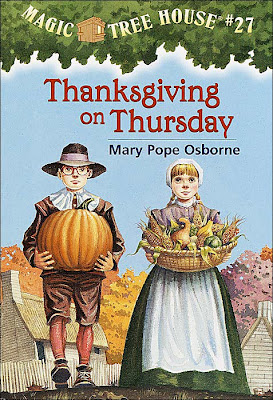
For new readers, you can't beat Magic Tree House: Thanksgiving on Thursday. This is an early chapter book level on a par with Junie B. Jones. Nice story of Jack and Annie and the preparations for the first Thanksgiving.
 Squanto's Journey -- after all he went through, it's hard to see why he'd want to help any Europeans do anything except jump off a cliff. But he did and this gorgeously illustrated book written by Joseph Bruchac, a Native American, tells the story. A picture book, but lots of text, so probably for older kids.
Squanto's Journey -- after all he went through, it's hard to see why he'd want to help any Europeans do anything except jump off a cliff. But he did and this gorgeously illustrated book written by Joseph Bruchac, a Native American, tells the story. A picture book, but lots of text, so probably for older kids.
N.C. Wyeth's Pilgrims is similar to Squanto's Journey -- lots of text and beautiful artwork, this time by an American Master. Reading it is like taking a little art appreciation class.
Thursday, November 18, 2010
Great Authors: Jean Ferris

Jean Ferris is probably best known for Once Upon a Marigold and its sequel Twice Upon a Marigold, her updated fairy tales about a mind-reading princess, a runaway boy and the dwarf who cares for him, an evil queen, and the tooth fairy. However, Ms. Ferris has been around for quite a while and is deserving of a wider audience. Her fiction is wonderful for young adults and upper elementary kids -- full of humor and emotion and exiting action. What I love most about Jean Ferris is her selection of quirky, screwball comedies. The two Marigolds fall into this category, as do Love Among the Walnuts and Much Ado About Grubstake. There's a quality to them that makes me think of John Irving (The World According to Garp); they are full of characters that in other novels would be hopeless misfits and yet in Ferris's stories they are valued individuals and important to the resolution of the story.
What I love most about Jean Ferris is her selection of quirky, screwball comedies. The two Marigolds fall into this category, as do Love Among the Walnuts and Much Ado About Grubstake. There's a quality to them that makes me think of John Irving (The World According to Garp); they are full of characters that in other novels would be hopeless misfits and yet in Ferris's stories they are valued individuals and important to the resolution of the story.
It's practically impossible to describe the plot of Love Among the Walnuts, other than to say that it involves a mental institution, a pair of evil uncles, and two people and a chicken who've been put in a coma. In Much Ado About Grubstake, 16 year old Arley has to outsmart a powerful businessman who is trying to buy up all the played-out mines in tiny, run-down Grubstake. That she has to manage this with a misfit collection of townspeople and reformed bad guys is part of the novel's charm.
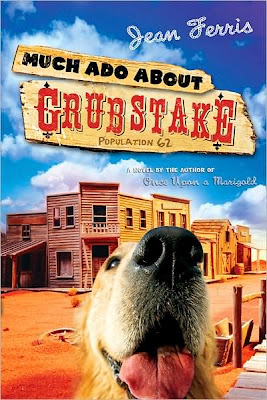 Her comedies always bring together strange assortments of people with all their quirks and oddities and over the course of the story they manage to find family in each other. I love that about her work.
Her comedies always bring together strange assortments of people with all their quirks and oddities and over the course of the story they manage to find family in each other. I love that about her work.All of her comedies are suitable for younger readers -- say 3rd grade and up -- but would also work for older readers right through high school. They are great vocabulary stretchers, too, so much so that I had my 9 year old start making lists of words she wasn't sure about. She's probably added 50 new words to her vocabulary thanks to Jean Ferris.
 Ferris also has some more serious novels and these would be more appropriate for a little older audience. Of Sound Mind is a fascinating book about a boy who is hearing but has been raised by deaf parents. Theo's role as family interpreter is explored even as it changes when his father has a stroke and his self-absorbed mother can't bear to take care of him. Once again, Ferris does a nice job of portraying people with all their warts, though this time with a more serious bent.
Ferris also has some more serious novels and these would be more appropriate for a little older audience. Of Sound Mind is a fascinating book about a boy who is hearing but has been raised by deaf parents. Theo's role as family interpreter is explored even as it changes when his father has a stroke and his self-absorbed mother can't bear to take care of him. Once again, Ferris does a nice job of portraying people with all their warts, though this time with a more serious bent. Into the Wind is part one of a three-part series which is more or less a romance for high schoolers, complete with an orphaned heroine and a dashing pirate who rescues her. It takes place in 1814, is loaded with action, and provides some historical detail, all in a wholesome, totally-appropriate-for-older-teens story (no bodice ripping here, folks).
Into the Wind is part one of a three-part series which is more or less a romance for high schoolers, complete with an orphaned heroine and a dashing pirate who rescues her. It takes place in 1814, is loaded with action, and provides some historical detail, all in a wholesome, totally-appropriate-for-older-teens story (no bodice ripping here, folks).Underground is another historical novel, this time exploring slavery. The main character, Charlotte, is a slave at the Mammoth Cave Hotel. When she discovers runaway slave sometimes come to the hotel on their way north, Charlotte has to decide whether she, too, will run away or stay with Stephen, another slave who doesn't feel the need or desire to leave. Another one which would be good for junior high and up.
Monday, November 15, 2010
Say What?
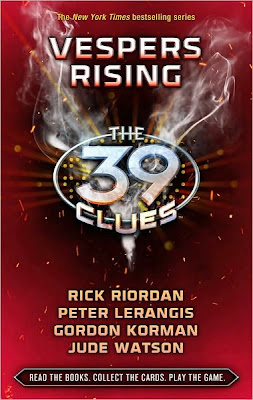
Does anyone else feel like they've been had on this one?
Anyone? Bueller? Bueller?
I willingly bought into (and bought) the 39 Clues books because my 4th grader loved them. My husband and I read them, too, and liked them, though they weren't the same caliber as the Percy Jackson and the Olympians series. I was pleased that Amy and Dan's adventures were able to end gracefully and coherently. Good closure and all that.
But now they're back. And I am not sure how I feel about that.
Wait -- I am sure how I feel about it: I feel like they're merely trying to extend a lucrative franchise, that it's less about compelling storytelling than it is about the cha-ching. And maybe I wouldn't feel like I'm being pumped for whatever else might be in my wallet if we hadn't already bought all the 39 clues books (oh yeah, all 10).
Hmmmm. Since I have a bad habit of mouthing of without a ton of thought beforehand, I'm going to officially state that BOOKIVORE RESERVES JUDGEMENT ON THE NEW VESPERS SERIES UNTIL SHE READS THE FIRST BOOK.
Then I'm going to remind myself when I get all twitchy and miffy and such that I have RESERVED JUDGEMENT.
Right. Glad we cleared that up.
NOTE: yes, I read about the "other, powerful family" in the last 39 Clues book, but for some reason I just didn't think they'd be starting a new series so soon after the first one. But I did grasp that there would be a new series. Truly, I are not so dumb.
Thursday, November 11, 2010
Literacy Bags

 The book was Down By the Bay, which is based on the Raffi song by the same name. The literacy bag contained 3 types of activities: a matching activity with rhyming words, a puzzle activity, and a second rhyming activity that went beyond the rhymes in the book. The picture above is the first rhyming activity -- matching a picture with another picture that rhymes. We had a picture of a pear and a bear, a bat and a hat, and so on.
The book was Down By the Bay, which is based on the Raffi song by the same name. The literacy bag contained 3 types of activities: a matching activity with rhyming words, a puzzle activity, and a second rhyming activity that went beyond the rhymes in the book. The picture above is the first rhyming activity -- matching a picture with another picture that rhymes. We had a picture of a pear and a bear, a bat and a hat, and so on.
Then we had a set of very simple puzzles -- just line drawings of animals from the story cut into pieces and laminated. The final activity, below, was to come up with some objects from around the house and then think of words that rhyme with them. The theme here was "things that rhyme."
 Another bag that she brought home the following week was for the book The Gingerbread Boy. This one was even more simple -- just the book and a selection of felt pieces depicting characters or objects necessary to the story.
Another bag that she brought home the following week was for the book The Gingerbread Boy. This one was even more simple -- just the book and a selection of felt pieces depicting characters or objects necessary to the story. We used the pieces to retell the story, then we used them to sequence the events of the story -- first the Gingerbread Boy met the cow, then the horse, then the farmer, then the fox. First he sat on the fox's tail, then his back, then his head, then his nose...and we moved the gingerbread boy each time to the right position.
We used the pieces to retell the story, then we used them to sequence the events of the story -- first the Gingerbread Boy met the cow, then the horse, then the farmer, then the fox. First he sat on the fox's tail, then his back, then his head, then his nose...and we moved the gingerbread boy each time to the right position. If you are a homeschooler, or a teacher, or a parent volunteer, Literacy Bags are something you can make yourself. You could even throw some together for vacation days and summer activities if, like me, you are desperate for stuff your kids can do when there's no school. Below are a couple of resources for creating your own bags. Neither are in print anymore, but they are readily available from Amazon and Barnes and Noble's used book sellers and from Better World Books.
If you are a homeschooler, or a teacher, or a parent volunteer, Literacy Bags are something you can make yourself. You could even throw some together for vacation days and summer activities if, like me, you are desperate for stuff your kids can do when there's no school. Below are a couple of resources for creating your own bags. Neither are in print anymore, but they are readily available from Amazon and Barnes and Noble's used book sellers and from Better World Books.

Monday, November 8, 2010
The Missing
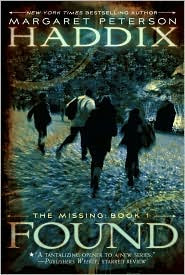 The Missing is Margaret Peterson Haddix's newest series and I have to say, it's a original idea. In fact, as I was reading volume one, Found, I couldn't predict what was actually going on. When the twist was revealed, I was intrigued.
The Missing is Margaret Peterson Haddix's newest series and I have to say, it's a original idea. In fact, as I was reading volume one, Found, I couldn't predict what was actually going on. When the twist was revealed, I was intrigued.Jonah was adopted as a baby. He's always known he was adopted and he is not much bothered by this fact. His parents obviously love him and Haddix pokes gentle fun at them for their perhaps overly-earnest desire to be sensitive to Jonah's adoption "issues," should he ever begin to have any. However, things begin to happen that lead Jonah to wonder just what the circumstances surrounding his adoption were. He meets Chip, a new kid in his neighborhood, and then he gets a bizarre letter. It's a simple piece of white paper that says "You are one of the missing."
 Jonah dismisses it as a prank, but when Chip gets the same letter, the boys begin to wonder what it means. Jonah thinks it might have something to do with his adoption, but Chip isn't adopted -- is he? Turns out he is, and his parents have kept that fact from him his entire life. Then the boys get another letter: "Beware. They're coming back to get you."
Jonah dismisses it as a prank, but when Chip gets the same letter, the boys begin to wonder what it means. Jonah thinks it might have something to do with his adoption, but Chip isn't adopted -- is he? Turns out he is, and his parents have kept that fact from him his entire life. Then the boys get another letter: "Beware. They're coming back to get you."With Jonah's younger sister Katherine, they begin to investigate where they might have come from and discover they're part of a group of 36 kids who were all adopted and who now, mysteriously, have migrated from all over the country to the community where Jonah and Chip live.
I'm going to give some spoilers here, so if you don't want to know the twist on which this whole series rests, stop reading now and go check out Found from your local library.
 What is it all about? In a word, time travel. I know -- you didn't see that coming, did you? Me neither. Turns out Jonah and Chip and the other kids were kidnapped out of time in a cosmic baby-smuggling ring. And they were kidnapped because they were important personages in history -- the Princes in the Tower, Virginia Dare, Anastasia Romanoff, Chinese princesses, philosophers...people who would have died too soon but instead were "rescued" to be adopted by prestige-seeking parents in the distant future. In a bungled baby-snatch, the 36 kids were accidentally crash landed in the late 20th century -- a plane-load of babies, mysteriously appearing on a small regional runway.
What is it all about? In a word, time travel. I know -- you didn't see that coming, did you? Me neither. Turns out Jonah and Chip and the other kids were kidnapped out of time in a cosmic baby-smuggling ring. And they were kidnapped because they were important personages in history -- the Princes in the Tower, Virginia Dare, Anastasia Romanoff, Chinese princesses, philosophers...people who would have died too soon but instead were "rescued" to be adopted by prestige-seeking parents in the distant future. In a bungled baby-snatch, the 36 kids were accidentally crash landed in the late 20th century -- a plane-load of babies, mysteriously appearing on a small regional runway.Unfortunately, their kidnappings have wounded Time and while one faction of time travellers is trying to snatch them back so they can be adopted in the future, another faction is equally determined to return them to their proper times so they can die as they were meant to do. Neither option is very appealing to the kids. If they go forward, they'll be regressed to babies and have to grow up all over again. If they go back, well...they die.
Eventually, the faction trying to restore Time to its proper path wins and Chip is sent back to 15th century England with another boy, Alex, to fulfill their destiny as the Princes in the Tower. But Jonah and Katherine manage to hitch a ride with Chip and are also catapulted back to the 1400s. They are reluctantly given the chance to "put things right" in a way that heals Time and spares their friends. And that is the subject of the second book, Sent.
Haddix has laid the groundwork for a very ambitious series here -- at lot of books, if she truly plans to cover each child on the plane (one child doesn't show up for the big adoption reunion and Jonah's sister, Katherine, who is not adopted, takes her place; Alex and Chip are handled in one book, but still, there are a lot of kids to cover). That ought to be enough to keep her busy for a while. The books are well written and do a nice job of combining the time-travel elements with actual history. These are books that do a lot to illuminate events and people from the past, so they get my vote just for that.
I don't know what adopted kids will make of this series. Certainly there's a kind of wish fulfillment here, finding out that your birth parents were royalty or famous or whatever -- like everyone wanting to believe they were Napoleon or Lady Godiva or Cleopatra in a former life instead of Joe the Pig Farmer. It might pass completely below the radar for adopted kids, or it might open some doors to talk about birth parents and what you actually know about them. Jonah and Chip present different adoption experiences, with Jonah's all very open and above-board and Chip's hidden as though it were completely immaterial, or even embarassing. Chip also feels "out of place," which is put down to his being literally "out of time," but his feelings may provoke a response in some adopted kids (and bio kids as well; feeling out of place can just be a teenage condition, too). I think parents of adopted kids should read this first so they know what kinds of ideas or questions or issues might be raised by the story.
Thursday, November 4, 2010
39 Clues: Into the Gauntlet

Monday, November 1, 2010
The Lost Hero
